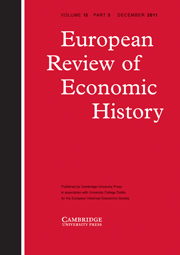Crossref Citations
This article has been cited by the following publications. This list is generated based on data provided by
Crossref.
Wolf, N.
2010.
Europe's Great Depression: coordination failure after the First World War.
Oxford Review of Economic Policy,
Vol. 26,
Issue. 3,
p.
339.
Rathke, Alexander
Straumann, Tobias
and
Woitek, Ulrich
2011.
Overvalued: Swedish Monetary Policy in the 1930s.
SSRN Electronic Journal,
Boianovsky, Mauro
2011.
Fisher and Wicksell on Money: A Reconstructed Conversation.
SSRN Electronic Journal,
Mathy, Gabriel P.
and
Meissner, Christopher M.
2011.
Business cycle co-movement: Evidence from the Great Depression.
Journal of Monetary Economics,
Vol. 58,
Issue. 4,
p.
362.
Urban, Scott
and
Straumann, Tobias
2012.
Still tied by golden fetters: the global response to the US recession of 1937–1938.
Financial History Review,
Vol. 19,
Issue. 1,
p.
21.
Boianovsky, Mauro
2013.
Fisher and Wicksell on money: A reconstructed conversation.
The European Journal of the History of Economic Thought,
Vol. 20,
Issue. 2,
p.
206.
Shibamoto, Masahiko
and
Shizume, Masato
2014.
Exchange rate adjustment, monetary policy and fiscal stimulus in Japan's escape from the Great Depression.
Explorations in Economic History,
Vol. 53,
Issue. ,
p.
1.
Schenk, Catherine
and
Straumann, Tobias
2016.
Central Banks at a Crossroads.
p.
319.
Rathke, Alexander
Straumann, Tobias
and
Woitek, Ulrich
2017.
OVERVALUED: SWEDISH MONETARY POLICY IN THE 1930s.
International Economic Review,
Vol. 58,
Issue. 4,
p.
1355.
Jansson, Walter
2018.
Stock markets, banks and economic growth in the UK, 1850–1913.
Financial History Review,
Vol. 25,
Issue. 3,
p.
263.
Jansson, Walter
2018.
Stock Markets, Banks and Economic Growth in the UK, 1850-1913.
SSRN Electronic Journal ,
Sabaté, Marcela
Fillat, Carmen
and
Escario, Regina
2019.
Budget deficits and money creation: Exploring their relation before Bretton Woods.
Explorations in Economic History,
Vol. 72,
Issue. ,
p.
38.
Battilossi, Stefano
and
Yago, Kazuhiko
2020.
Handbook of the History of Money and Currency.
p.
1.
Battilossi, Stefano
and
Yago, Kazuhiko
2020.
Handbook of the History of Money and Currency.
p.
1.
Jernudd, Åsa
and
Sedgwick, John
2022.
Towards a Comparative Economic History of Cinema, 1930–1970.
p.
87.
Berg, Claes
2025.
Gunnar Myrdal.
p.
41.


